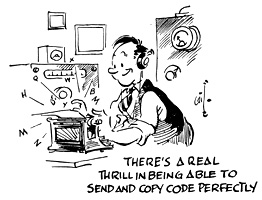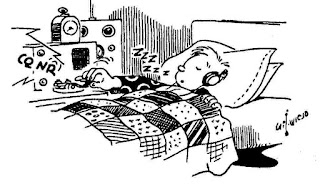 The Joy Of CW
The Joy Of CW
 |
| courtesy: http://www.arrl.org/ |
I receive a lot of e-mail from both hams and future hams that are struggling with CW. It seems there are a lot of hams that don't operate any CW simply because of their code skills. For myself, learning CW as a pre-teen, was a bit of a struggle, as I learned CW from flash cards ... definitely the wrong way. In my case, the code was learned in order to operate an Aldis lamp signalling system for my scouting activities. When eventually switching to a hand key and buzzer, I had to make the mental switch between the picture of the flash card and the sound of the code, taking me much longer to reach my goals than if I had learned just by sound.
If I were learning the code today, or if advising anyone struggling with CW, I would suggest several ways of making it easier.
1. Too many newcomers want to learn CW using a keyer. Put the keyer away and get yourself a hand key. It need not be fancy or expensive.
2. Use the hand key to practice sending similar-sounding letters (E, I, S, H etc) slowly and correctly. Don't be concerned about sending them fast but concentrate on getting a uniform spacing between each element of the letter. As you slowly learn the letters and how they sound, you will find your sending speeding-up, unconsciously, as you progress.
3. Combine your sending practice with receiving practice and try to do 10 minutes of each during each practice session. One session per day will guarantee success, if you stick with it. If you can't do it every day then try and commit to every other day.
4. For receiving practice, use a much higher speed than what you are sending at. Once again, in sets of similar-sounding letters, try and learn the letters when sent at a speed of at least 15WPM, but with wide spaces between each letter ... so they aren't coming at you as fast. This is the Farnsworth method of learning code. Learning what the letters sound like when sent at a fast speed will eliminate the dreaded 'learning plateaus' associated with learning at slower speeds, when you can get stuck at a lower speed for some length of time. I only wish that I had known of this method when I was a kid, but I don't think it had been thought of back then.
5. There are lots of websites that will help you in Step 4 and one that I have played with seems to work very well. You can set up a slow-speed spacing but have characters sent at 15WPM or faster (start with 15WPM). You can pick only the letters that you wish to practice (T,M,O,A,N etc) and then get a printout of what was actually sent to check your accuracy. The one I tested is by AA9PW and can be found here.
In addition, the ARRL's W1AW, provides nightly code practice on various frequencies and also provides archived CW practice sessions at various speeds via their website here.
Once you become somewhat competent in both sending and receiving, don't be afraid to get on the air and use your new skills. Don't be concerned about sending fast and be careful about sending faster than you can receive, an easy trap to fall into.
There are always several stations around 7.110-7.125 every afternoon and evening that seem very happy to communicate at comfortable speeds. If you don't get on-the-air, then make sure that you still do your daily 20 minutes of practice. You will be amazed at how quickly you can learn the code or increase your speed, with this daily routine. This short daily commitment to practice (on the air or otherwise) is the key to success.
If you aren't using CW, you are missing out on a lot of fun. To this day, CW is still my favorite mode and almost 100% of my on-air operating is on CW ... it's just plain fun! Knowing how to use CW will open up a lot of opportunities to enjoy it ... CW contesting, chasing DX, CW nets, staying in touch with friends etc ... CW will always get through better than phone under most conditions.
 |
| courtesy: http://www.arrl.org/ |
So ... if you have been struggling with the code, or putting it off, there's no time like the present to join the fun. Hopefully you will find these suggestions helpful.














Very good post Steve.
Excellent! tnx 73
I also note that 14.050 Mhz is very CW friendly. Lots of slow speed QSO’s mixed in with the QRP crowd. That’s where I go when I am looking for a nice rag chew session. You can also find the SK folks there looking for a contact most days.
Thanks for the article Steve. 73’s
Very good article Steve. I kind of sort of learned morse code in 1963 when I got my novice license. I was just getting to 13 wpm and in those days you either went to tech, general or off the air. I was having trouble since I learned wrong and that carried over to my really bad time on the air. I really wanted to get code mastered and the clock ran down and I ended up with a Tech license. No tech plus in those days. My area did not have any CW on 6 and 2 meters and 6 meters was a vast waste land. Today most radios come standard with 6 meters. Back in the good old days they didn’t..Then we had the brain damaged ARRL pushing, not tech plus, but incentive licensing that almost killed ham radio.
So now in my mid 60’s and I am unlearning and relearning and I have been on a couple of times recently and plan on more in the months to come. I have the radios, a Kent straight key and one day use a K8RA (sk) P-1 paddle. Radios, KX3, K3, IC-756PROII and a IC-7100. I am set…Now to get on and have fun making a fool out of myself and have fun doing it until I can do better…BTW from day one of my relearning, I decided not to write down when coping, but listening and trying to convert sounds to letters in my head. Treating morse code as a language… Seems to be working. At 10 wpm 100% copy in my head and at 15 wpm about 75%… I don’t think that is bad for someone hard of hearing, with S-7 ringing in my ears at 67 yrs old…hi and 73
One good hint that I’ve found while teaching Morse Code Class:
As we age, our hearing gets less able to “HEAR” each Dit & Dah.
When sending at faster speeds, those hard of hearing, will miss just how many Dits or Dahs were sent for each Letter or Number. Please raise the Volume of your speaker, so that student can hear o.k. Using a set of Headphones is an excellent way to get that CW copied, as the sounds are right at your Ears !
(It’s also an excellent way to keep peace in your house, as it’s quiet to all but you !)
Each Letter & Number has it’s own unique sound, & learning to send on a Hand-Key forces you to learn just how each should be sent. Listen to the cadence of each individual Letter or Number. Don’t be in such a rush to send or copy fast. There are only about 50 or so Charactors & Numbers to learn to send & copy. Making a CW QSO is Simple, Quick, & Short. For an honest 2-way QSO, you need to copy & have Both Call Signs, (Yours & your contact), & both RST signal reports. In most Contests, that’s what is Sent, back & forth. As an example: I copy KH6SP sending CQ, When he is done calling CQ, he will turn it over with: (CQ CQ CQ de, KH6SP KH6SP KH6SP K). That is when you can call him. You have copied his call correctly & call him: (KH6SP DE, KD0QV KD0QV K)
If he has a copy on you, he will respond with: (KD0QV DE, KH6SP RST 599 599 BK) (BK is a quick way to return it to you.) You then respond with (KH6SP DE,KD0QV RST 599 599 TNX QSO 73 DE, KD0QV SK) There, a quick & simple honest QSO ! Get that info passed first, then carry on with any Ragchew ! Band condx can & will change quickly, so get the Basics first! Copy what is sent correctly, & Send your Call & RST at your speed, Clear & Correctly ! If it’s too fast for you, simply ask by sending:(BK PSE QRL BK). Don’t be afraid to ask for repeats, if you missed the copy, like: (BK RST ? BK) Most Hams will slow,(QRS), their CW speed down for you, so you can make the QSO. There is “NO SPEED LIMIT” SENDING MORSE CODE. Please do your part, correctly sending your info, & at a smooth speed, so he can copy what you send ! Listen in on a Contest Day & you’ll soon get the hang of what is being Sent for QSO’s
It’s also an excellent time to make DXCC contacts the World over for your own DXCC totals. Keep it SIMPLE & SMOOTH & HAVE FUN LEARNING MORSE CODE ! DE, KD0QV–JIM
Learning the way letters and eventually whole words sound when received as a whole is the key. Put the concept of remembering or writing down letters as they are received away, that’s a sure path to failure. Later, when you are receiving with some proficiency, you will find that understanding or writing whole words down as you receive them will be similar to taking notes in class. Sending is easier. Concentrate on receiving first, then on the quality of your sending. Once you “own” the code, you will wonder how you got along operating without it. Best 73’s